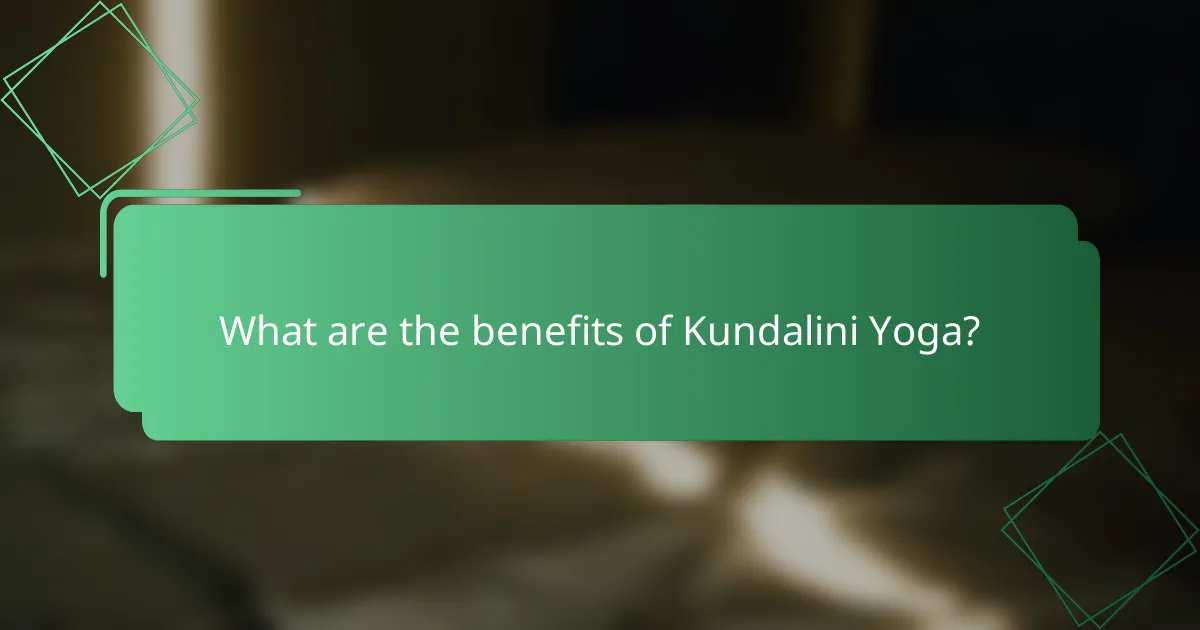Kundalini Yoga is a transformative practice that awakens the dormant energy at the base of the spine, promoting spiritual growth and heightened awareness. By integrating breathwork, chakra activation, and meditation, it facilitates a powerful flow of energy throughout the body, leading to enhanced mental clarity and emotional stability. Engaging in this practice can result in profound personal transformation and a deeper connection to oneself.

How can Kundalini Yoga awaken energy?
Kundalini Yoga awakens energy by activating the dormant Kundalini energy at the base of the spine, facilitating spiritual growth and heightened awareness. This practice combines various techniques such as breathwork, chakra activation, and meditation to enhance the flow of energy throughout the body.
Breathwork techniques
Breathwork in Kundalini Yoga, known as Pranayama, is essential for awakening energy. Techniques like “Kapalabhati” (skull shining breath) and “Nadi Shodhana” (alternate nostril breathing) help clear energy pathways and increase oxygen flow. Practicing these techniques for a few minutes daily can significantly enhance your energy levels.
Focus on rhythmic breathing to synchronize your breath with movement and meditation. This alignment can amplify the effects of your practice and promote a deeper connection with your inner self.
Chakra activation
Chakra activation is a fundamental aspect of Kundalini Yoga, as it involves energizing the seven main chakras located along the spine. Each chakra corresponds to different emotional and spiritual aspects, and activating them can lead to a balanced energy flow. Techniques such as visualization and specific asanas can help in this activation process.
Consider incorporating practices that focus on each chakra, such as chanting specific sounds or performing targeted poses. This approach can enhance your overall energy and emotional well-being.
Asanas for energy flow
Asanas, or yoga postures, play a crucial role in facilitating energy flow in Kundalini Yoga. Poses like “Cobra” and “Bridge” are particularly effective for stimulating the spine and opening energy channels. Regular practice of these asanas can lead to increased vitality and flexibility.
Incorporate a sequence of dynamic movements to create heat and awaken energy. Aim for a balanced routine that includes both strengthening and stretching poses to ensure comprehensive energy activation.
Mantra chanting
Mantra chanting is a powerful tool in Kundalini Yoga for awakening energy and elevating consciousness. Reciting specific mantras can resonate with different chakras, helping to clear blockages and enhance spiritual awareness. Common mantras include “Sat Nam,” which means “truth is my identity.”
Engage in group chanting or practice alone to deepen your experience. The vibrational quality of sound can significantly amplify the energy awakening process, making it a vital component of your practice.
Guided meditations
Guided meditations in Kundalini Yoga provide structured support for energy awakening and spiritual growth. These meditations often focus on visualizations and affirmations that align with the Kundalini energy. They can help practitioners connect more deeply with their inner selves and facilitate emotional release.
Consider using audio or video resources that offer guided sessions tailored to specific goals, such as stress relief or increased focus. Regularly dedicating time to these meditations can enhance your overall energy and spiritual awareness.

What are the benefits of Kundalini Yoga?
Kundalini Yoga offers a range of benefits that enhance spiritual awakening, mental clarity, emotional stability, and physical health. Practicing this form of yoga can lead to profound personal transformation and a deeper connection to oneself.
Enhanced spiritual growth
Kundalini Yoga is designed to awaken the dormant energy within, facilitating a journey toward spiritual enlightenment. Through specific techniques such as breath control (pranayama), meditation, and chanting, practitioners can experience heightened awareness and a stronger connection to their inner selves.
Regular practice can lead to transformative experiences, including increased intuition and a sense of purpose. Engaging with the spiritual aspects of Kundalini Yoga can help individuals explore their beliefs and deepen their understanding of life’s mysteries.
Increased mental clarity
One of the key benefits of Kundalini Yoga is its ability to improve mental clarity. The meditative practices involved help calm the mind, reducing distractions and enhancing focus. This clarity can be particularly beneficial in daily decision-making and problem-solving.
Practitioners often report improved cognitive function, which can manifest as better memory retention and quicker processing of information. Incorporating mindfulness techniques from Kundalini Yoga into your routine can help maintain this mental sharpness throughout the day.
Improved emotional balance
Kundalini Yoga promotes emotional stability by helping individuals process and release negative emotions. The combination of physical movement, breathwork, and meditation allows for the expression of feelings, leading to a more balanced emotional state.
Regular practice can reduce anxiety and stress levels, fostering resilience against emotional upheaval. Techniques such as mantra chanting can also create a sense of calm and grounding, making it easier to navigate life’s challenges.
Physical health improvements
Engaging in Kundalini Yoga can lead to various physical health benefits, including increased flexibility, strength, and overall vitality. The physical postures (asanas) are designed to stimulate the body’s energy centers, promoting better circulation and organ function.
Additionally, practitioners may experience improvements in respiratory health due to breath control exercises. As a holistic practice, Kundalini Yoga can also support weight management and enhance overall fitness levels, contributing to a healthier lifestyle.

How to start practicing Kundalini Yoga?
To start practicing Kundalini Yoga, find a class or online resource that fits your schedule and level. Begin with basic techniques focusing on breath, movement, and meditation to awaken your energy and enhance spiritual growth.
Finding local classes in New York
New York offers a variety of Kundalini Yoga classes across different neighborhoods. Look for studios that specialize in this practice, such as Golden Bridge or Yoga Bhakti, which often provide beginner-friendly sessions.
Check community boards, local yoga directories, or platforms like ClassPass to discover classes that suit your schedule. Many studios also offer introductory deals, making it easier to try multiple classes before committing.
Online resources and courses
For those who prefer online learning, numerous platforms offer Kundalini Yoga courses. Websites like YogaGlo and Gaia provide extensive libraries of video classes led by experienced instructors.
Additionally, YouTube channels dedicated to Kundalini Yoga can be a free resource for beginners. Look for playlists that focus on foundational practices to help you get started at your own pace.
Essential equipment and attire
To practice Kundalini Yoga, you need minimal equipment. A comfortable yoga mat is essential for floor exercises, while a blanket can provide support during meditation.
Wear breathable, flexible clothing that allows for movement. Many practitioners prefer white attire, as it is believed to enhance energy flow, but any comfortable outfit will suffice for beginners.

What should I consider before starting Kundalini Yoga?
Before starting Kundalini Yoga, it’s essential to understand its unique focus on energy awakening and spiritual growth. Consider your physical health, mental readiness, and the importance of finding a qualified instructor to guide your practice.
Health conditions and contraindications
Individuals with certain health conditions should approach Kundalini Yoga with caution. Those with heart issues, severe anxiety, or other significant medical concerns should consult a healthcare professional before starting. Pregnant women and individuals with epilepsy or severe mental health disorders may also need to avoid specific practices.
It’s advisable to listen to your body and modify poses as needed. If you experience discomfort or adverse reactions during practice, stop and seek guidance from a qualified instructor.
Choosing the right instructor
Selecting a qualified Kundalini Yoga instructor is crucial for a safe and effective experience. Look for instructors with recognized certifications and experience in teaching Kundalini Yoga specifically. Personal recommendations and online reviews can also help in finding a reputable teacher.
Consider attending a few trial classes to assess the instructor’s teaching style and how well it aligns with your learning preferences. A good instructor should create a supportive environment and provide modifications for different skill levels.

What are common misconceptions about Kundalini Yoga?
Common misconceptions about Kundalini Yoga often stem from misunderstandings regarding its practices and effects. Many people believe it is solely about physical postures or that it leads to uncontrollable spiritual experiences, which can deter potential practitioners.
Misunderstanding of energy awakening
Energy awakening in Kundalini Yoga refers to the activation of dormant energy within the body, often visualized as a coiled serpent at the base of the spine. This process is gradual and requires consistent practice, including asanas, breathing techniques, and meditation. It’s important to approach this awakening with patience and a grounded mindset, as rushing can lead to discomfort or confusion.
Practitioners should be aware that energy awakening does not guarantee immediate enlightenment or dramatic experiences. Instead, it often manifests as subtle shifts in awareness, emotional balance, and increased vitality over time. Regular practice can help in navigating these changes effectively.
Myths about spiritual experiences
Many myths surround the spiritual experiences associated with Kundalini Yoga, including the belief that they are always intense or ecstatic. In reality, spiritual experiences can vary widely among individuals and may include feelings of peace, clarity, or even discomfort as one processes deeper emotions. Understanding this variability can help manage expectations.
It’s crucial to maintain a supportive environment and possibly seek guidance from experienced teachers during these experiences. Practitioners should avoid comparing their journeys with others, as each individual’s path is unique. Emphasizing personal growth and self-awareness can lead to a more fulfilling practice.

How does Kundalini Yoga differ from other yoga styles?
Kundalini Yoga is distinct from other yoga styles primarily due to its emphasis on awakening the Kundalini energy that resides at the base of the spine. This practice combines physical postures, breath control, and meditation to facilitate spiritual growth and heightened awareness.
Focus on energy and chakras
Kundalini Yoga centers on the concept of energy flow through the body’s chakras, which are energy centers aligned along the spine. Practitioners aim to awaken the dormant Kundalini energy, allowing it to rise through these chakras, leading to increased vitality and spiritual enlightenment. This focus on energy differs from other styles, which may prioritize physical alignment or relaxation.
The practice often includes specific meditations and breathing techniques designed to clear blockages in the chakras, promoting a balanced energy flow. Understanding the chakra system is essential for practitioners, as each chakra corresponds to different aspects of physical, emotional, and spiritual health.
Use of specific techniques
Kundalini Yoga employs a variety of techniques, including Kriyas, which are sets of exercises and meditations aimed at achieving specific outcomes. These Kriyas often involve repetitive movements, breath patterns, and mantras, creating a dynamic practice that can lead to profound experiences.
Additionally, the use of mudras (hand gestures) and bandhas (body locks) is common, enhancing the flow of energy and deepening the meditative state. Beginners should start with simpler Kriyas and gradually progress to more complex sequences to avoid overwhelm and ensure a safe practice.










